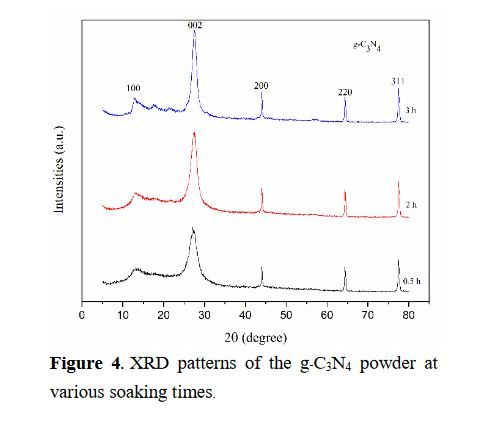Simple Method to Synthesize g-C3N4 Doped Sn to Reduce Bandgap Energy (Eg)
DOI:
https://doi.org/10.53848/ssstj.v9i2.235Keywords:
Graphitic carbon nitride, Bandgap energy, Light absorptionAbstract
Graphitic carbon nitride (g-C3N4) has been highlighted in its unique electronic structure with a medium bandgap, high thermal and chemical stability in the ambient environment. It is promoted as a photocatalytic material. To enhance photocatalytic properties, Sn-modified g-C3N4 was synthesized from urea and Sn powder. Firstly, urea was fired at 450-650oC in the air to synthesize g-C3N4 powder. Then such g-C3N4 powder was mixed with Sn powder for 0.1, 0.3, and 0.5 mole ratio and fired at 550oC in ambient. To investigate the phase formation and light absorption, XRD and light absorption spectrophotometers were performed, respectively. The light absorption value was used to calculate band gap energy (Eg). It was found that the XRD results of synthesized g-C3N4 were on the broad peak to narrow peak in synthesized temperatures 450-650oC. The light absorption of synthesized powder at 550oC was higher than others. Thus, synthesized powder at 550oC was chosen to mix with Sn powder. It observed that E g of Sn-modified g-C3N4 decreased depending on the amount of Sn and synthesized temperatures.
References
Alulema-Pullupaxi, P., Espinoza-Montero, P. J., Sigcha-Pallo, C., Vargas, R., Fernandez, L., Peralta-Hernandez, J. M., & Paz., J. L. (2021). Fundamentals and applications of photoelectrocatalysis as an efficient process to remove pollutants from water: A review. Chemosphere, 281, 130821. doi:10.1016/j.chemosphere.2021.130821
Huang, J., Ho, W., & Wang, X. (2014). Metal-free disinfection effects induced by graphitic carbon nitride polymers under visible light illumination. Chemical Communications, 50(33), 4338-4340. doi:10.1039/C3CC48374F
Kong, X., Liu, X., Zheng, Y., Chu, P. K., Zhang, Y., & Wu, S. (2021). Graphitic carbon nitride-based materials for photocatalytic antibacterial application. Materials Science and Engineering: R: Reports, 145, 100610. doi:10.1016/j.mser.2021.100610
Li, Y., Wu, S., Huang, L., Wang, J., Xu, H., & Li, H. (2014). Synthesis of carbon-doped g-C3N4 composites with enhanced visible-light photocatalytic activity. Materials Letters, 137, 281-284. doi:10.1016/j.matlet.2014.08.142
Naseri, A., Samadi, M., Pourjavadi, A., Moshfegh, A. Z., & Ramakrishna, S. (2017). Graphitic carbon nitride (g-C3N4)-based photocatalysts for solar hydrogen generation: Recent advances and future development directions. Journal of Materials Chemistry, 5, 23406-23433. doi:10.1039/C7TA05131J
Neelakanta Reddy, I., Veeranjaneya Reddy, L., Jayashree, N., Venkata Reddy, Ch., Cho, M., Kim, D., & Shim, J. (2021). Vanadium-doped graphitic carbon nitride for multifunctional applications: Photoelectrochemical water splitting and antibacterial activities. Chemosphere, 264, 128593. doi:10.1016/j.chemosphere.2020.128593
Shanmugam, V., Muppudathi, A. L., Jayavel, S., & Jeyaperumal, K. S. (2020). Construction of high
efficient g-C3N4 nanosheets combined with Bi2MoO6-Ag photocatalysts for visible-lightdriven photocatalytic activity and inactivation of bacterias. Arabian Journal of Chemistry, 13(1), 2439-2455. doi:10.1016/j.arabjc.2018.05.009
Song, Y., Gu, J., Xia, K., Yi, J., Chen, H., She, X., … Xu, H. (2019). Construction of 2D SnS2/g-C3N4 Z-scheme composite with superior visible-light photocatalytic performance. Apply Surface Science, 467-468, 56-64. doi:10.1016/j.apsusc.2018.10.118
Van, K. N., Huu, H. T., Nguyen Thi, V. N., Le Thi T. L., Truong, D. H., Truong, T. T., … Vasseghian, Y. (2022). Facile construction of S-scheme SnO2/g-C3N4 photocatalyst for improved photoactivity. Chemosphere, 289, 133120. doi:10.1016/j.chemosphere.2021.133120
Van Viet, P., Nguyen, H.-P., Tran, H.-H., Bui, D.-P., Hai, L. V., Pham, M.-T., … Thi, C. M. (2021). Constructing g-C3N4/SnO2 S-scheme heterojunctions for efficient photocatalytic NO removal and low NO2 generation. Journal of Science: Advanced Materials and Devices, 6(4), 551-559. doi:10.1016/j.jsamd.2021.07.005
Wen, J., Xie, J., Chen, X., & Li, X. (2017). A review on g-C3N4-based photocatalysts. Apply Surface Science, 391(Pt B), 72-123. doi:10.1016/J.APSUSC.2016.07.030
Zhang, W., Yu, C., Sun, Z., & Zheng, S. (2018). Visible-light-driven catalytic disinfection of Staphylococcus aureus using sandwich structure g-C3N4/ZnO/stellerite hybrid photocatalyst. Journal of Microbiology and Biotechnology, 28(6), 957-967. doi:10.4014/jmb.1712.12057
Zheng, Y., Liu, J., Liang, J., Jaroniec, M., & Qiao, S. (2012). Graphitic carbon nitride materials: Controllable synthesis and applications in fuel cells and photocatalysis. Energy & Environmental Science, 5(5), 6717-6731. doi:10.1039/C2EE03479D













